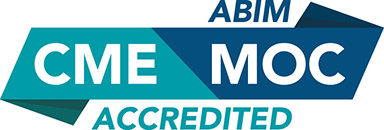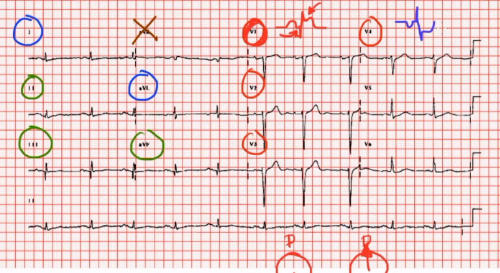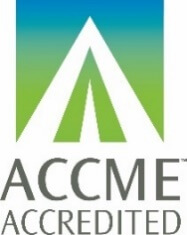EKG/ECG Interpretation Explained Clearly is a course designed to clarify, review, and augment the training and understanding of clinicians in the field of electrocardiogram interpretation. ECG interpretation remains an effective and low-cost diagnostic tool, yet the utility of the ECG is limited by clinician training, understanding, and skill. This course focuses on clarifying key ECG principals and practical interpretation skills useful for clinical practice - particularly for those in primary care and emergency settings. This activity will promote improved patient outcomes in a wide range of therapeutic areas encountered by clinicians – from chest pain to syncope, from tachycardia to possible medication toxicity.
This CME course will utilize a combination of videos, quizzes, and systematic discussion of practice ECGs to effectively deliver the course content. The modules included in this course take a departure from the traditional slide presentation style lecture. Instead, the course is comprised of a series of video lectures aided by real-time instructor-led chalkboard visuals. This method of learning allows for the subject matter to be broken down to the basics and is designed to increase learning and retention.
Learning Objectives:
As a result of this educational activity, participants should be better able to:
- Recognize the fundamentals and mathematical evaluation of the ECG: rates, rhythm, axis (QRS vectors), blocks (interval lengths), etc.
- Apply a systematic ECG interpretation “system” that may be utilized with each ECG encountered.
- Identify ECG abnormalities and review initial management principals.

Accreditation
AMA PRA Category 1 Credits™: Continuing Education Company, Inc. (CEC) is accredited by the Accreditation Council for Continuing Medical Education (ACCME) to provide continuing medical education for physicians.
Continuing Education Company, Inc. designates this enduring material for a maximum of 10 AMA PRA Category 1 Credits™. Physicians should claim only the credit commensurate with the extent of their participation in the activity.
ABIM MOC: Successful completion of this CME activity, which includes participation in the evaluation component, enables the participant to earn up to 10 Medical Knowledge MOC points in the American Board of Internal Medicine's (ABIM) Maintenance of Certification (MOC) program. Participants will earn MOC points equivalent to the amount of CME credits claimed for the activity. It is the CME activity provider's responsibility to submit participant completion information to ACCME for the purpose of granting ABIM MOC credit.

To receive CME credit and/or MOC points, you MUST complete the activity and the evaluation form. For ABIM MOC points, your information will be shared with the ABIM through the ACCME Program and Activity Reporting System (PARS). Please allow 6-8 weeks for your MOC points to appear on your ABIM records.
AAPA: AAPA accepts certificates of participation for educational activities certified for AMA PRA Category 1 Credit™ from organizations accredited by ACCME or a recognized state medical society. Physician assistants may receive a maximum of 10 hours of Category I credit for completing this activity.
AANPCP: The American Academy of Nurse Practitioners Certification Program (AANPCP) accepts AMA PRA Category 1 Credit™ from organizations accredited by the ACCME.
Release Date: 1/8/2019
Expiration Date: 1/8/2022 (Date after which this enduring material is no longer certified for credit).
Medium: Enduring Material, Video/Audio

Post-Test And Evaluation
After completing the CME activity, participant must successfully complete a post-test and fill out a program evaluation form. Upon completion, please email MedCram at [email protected] to request your certificate. Please contact MedCram if you need your certificate reprinted.
Faculty/Planning Committee Disclosures
Review Committee:
The following individuals have indicated that he/she (nor spouse/partner) have no relevant financial relationships with a commercial interest that may impact upon this CME activity:
- James Mathey, PA-C has no relevant financial relationships to disclose.
- Walter Ejnes, CHCP (Continuing Education Company) has no relevant financial relationships to disclose.
- Beth Townsend, HMCC – Reviewer (Continuing Education Company) has no relevant financial relationships to disclose.
Planning Committee Disclosures:
The following individuals have indicated that he/she (nor spouse/partner) have no relevant financial relationships with a commercial interest that may impact upon this CME activity:
- Walter Ejnes, CHCP (Continuing Education Company) has no relevant financial relationships to disclose.
- Sarah Lundquist-Galloway (Continuing Education Company) has no relevant financial relationships to disclose.
- Kyle Allred, PA-C (MedCram) has no relevant financial relationships to disclose.
Faculty Disclosures:
Roger D. Seheult, MD discloses that he was a consultant for Janssen Pharmaceuticals.
Unlabeled Use Declaration:
During their presentation, faculty may discuss unlabeled or investigational use which is not approved for a commercial product. Faculty members are required to disclose this information to the audience when referring to an unlabeled or investigational use.
Statement of Disclosure and Independence:
It is the policy of Continuing Education Company (CEC) to ensure all of its accredited educational activities are designed, implemented, and evaluated in accordance with the Accreditation Council for Continuing Medical Education’s (ACCME) Criteria and Policies. In accordance with ACCME requirements, CEC has Conflict of Interest (COI) and Disclosure Policies that are designed to ensure that accredited educational activities are fair, balanced, independent, evidence based, and based on scientific rigor.
All individuals who are in position to influence and/or control content of a CEC accredited Continuing Medical Education (CME) activity must disclose any relevant financial interest or other relationships which they or their spouse/partner have with (a) with the manufacturer(s) of any commercial products(s) and/or provider(s) of commercial services discussed in an educational presentation and (b) with any commercial supporters of the activity. (Relevant financial interest or other relationship includes such things as grants or research support, employee, consultant, major stockholder, member of speakers’ bureau, etc.) The intent of this disclosure is to provide activity participants with information to determine whether the speaker’s interests or relationships may influence the presentation with regard to exposition or conclusions. All potential conflicts of interest have been identified and resolved, and are listed above.
The opinions, ideas, recommendations, and perspectives expressed in the syllabus and accompanying presentations at this activity are those of the program authors and presenting faculty only and do not necessarily reflect the opinions, ideas, recommendations or perspectives of their affiliated institutions, Continuing Education Company, advisory boards or consultants.
Computer Requirements
Flash Player 10 or later, and one of the following browsers:
- Windows: Internet Explorer 6 and later, Microsoft Edge (latest version), Firefox 1.x and later, Google Chrome (latest version), Opera 9.5 and later
- Mac: Safari 3 and later, Firefox 1.x and later, Google Chrome (latest version)
- Linux: Firefox 1.x and later
HTML5 via one of the following browsers:
- Windows: Google Chrome (latest version)
- Mac: Safari 6.0.5 or later, Google Chrome (latest version)
- Mobile: Safari in Apple iOS 6 or later
Section 1: Physiology, Leads, Waves, & The Nervous System
- Pre Test
- Video 1: Intro to This Course & Review of The Heart (free trial) free trial
- Video 1 Quiz (free trial) free trial
- Video 2: Physiology of the Heart
- Video 2 Quiz
- Video 3: EKG Leads and Vectors
- Video 3 Quiz
- Video 4: Leads and EKG Paper
- Video 4 Quiz
- Video 5: The EKG Tracing
- Video 5 Quiz
- Video 6: EKG Waves, Complexes, and Intervals (P, QRS, T, etc.)
- Video 6 Quiz
- Video 7: The Autonomic Nervous System and The Heart
- Video 7 Quiz
Section 2: Rate, Rhythm, Premature Beats, and Pauses
- Video 8: Rate and Automaticity
- Video 8 Quiz
- Video 9: The R to R Interval and Rate Practice
- Video 9 Quiz
- Video 10: Rhythm & Arrhythmias
- Video 10 Quiz
- Video 11: Wandering Atrial Pacemaker & M.A.T.
- Video 11 Quiz
- Video 12: Escape Rhythms
- Video 12 Quiz
- Video 13: Premature Beats and Pauses
- Video 13 Quiz
- Video 14: Premature Beats Continued, Bigeminy, and Trigeminy
- Video 14 Quiz
Section 3: Tachyarrhythmias, Flutter, & Fibrillation
- Video 15: Tachyarrhythmias
- Video 15 Quiz
- Video 16: Ventricular Tachycardia
- Video 16 Quiz
- Video 17: Torsades de Pointes
- Video 17 Quiz
- Video 18: Atrial & Ventricular Flutter
- Video 18 Quiz
- Video 19: Fibrillation
- Video 19 Quiz
- Video 20: Wolff-Parkinson-White (WPW) Syndrome (free trial) free trial
- Video 20 Quiz (free trial) free trial
- Quadruple Board Certified in Internal Medicine, Pulmonary Medicine, Critical Care, and Sleep Medicine.
- Over 20 years teaching experience as both an exam preparation instructor and an assistant professor of medicine.
- Experience as a medical director for both a Southern California Physician Assistant Program and a Respiratory Therapy Program.
Click here for full bio

